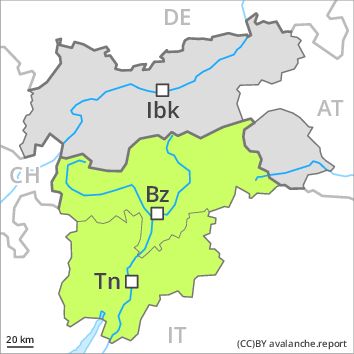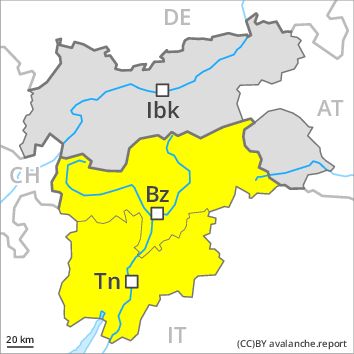Regions
Sexten Dolomites, Latemar, Val Müstair Alps, Langtaufers, Schnals Ridge, Southern Stubai Alps, Southern Zillertal Alps and High Tauern, Saldurn-Mastaun Ridge, Texel Mountains, Southern Adamello, Sarntal Alps, Adamello - Presanella, Western Pfunderer Mountains, Northern Brenta - Peller, Bondone and Stivo, Folgaria - Laverone, Southern Brenta, Southern Lagorai, Northern Lagorai, Maddalene, Pine' - Mocheni Valley, Eastern Pfunderer Mountains, Durreck Range, Western Rieserferner Mountains, Western Deferegger Alps, Ortler Range, Ulten Valley, Eastern Nonsberger Alps, Northern Dolomites of Fiemme, Gröden Dolomites, Primiero - Pale di S. Martino, Prags Dolomites, Prealps, Cembra Valley, Vallarsa, Western Nonsberg Alps, Fassa Valley, Sole, Pejo and Rabbi, Ledro Valley, Paganella, Marzola - Valsugana
AM
Danger level
Avalanche Problem
Persistent weak layer above 2400m, N-NE-NW
PM
Danger level
Avalanche Problem
Wet snow above 2800m, E-SE-S-SW-W
Persistent weak layer above 2400m, N-NE-NW
The danger of wet avalanches will increase during the day.
The Avalanche Warning Service currently has only a small amount of information that has been collected in the field, so that the avalanche danger should be investigated especially thoroughly in the relevant locality.
In very isolated cases weak layers exist deeper in the old snowpack. The avalanche prone locations are to be found in particular in extremely steep terrain. In some cases the avalanches are rather small and can mostly only be released by large loads.
As a consequence of warming during the day and the solar radiation, the likelihood of moist and wet avalanches being released will increase gradually. Wet avalanches can be released in deep layers of the snowpack and reach medium size. Transportation routes situated at higher altitudes and exposed parts of transportation routes are endangered in some cases especially at intermediate and high altitudes.
Snowpack
dp 10: springtime scenario
Outgoing longwave radiation during the night will be good over a wide area. The surface of the snowpack will freeze to form a strong crust and will already soften in the late morning. At intermediate altitudes the snow is wet. Individual weak layers exist in the old snowpack. At low altitude no snow is lying.
Tendency
Slight increase in danger of wet avalanches as a consequence of warming during the day and solar radiation.